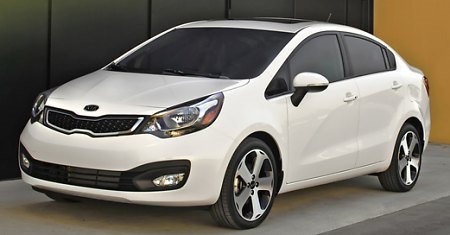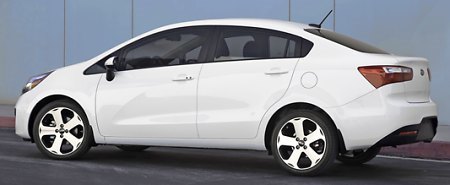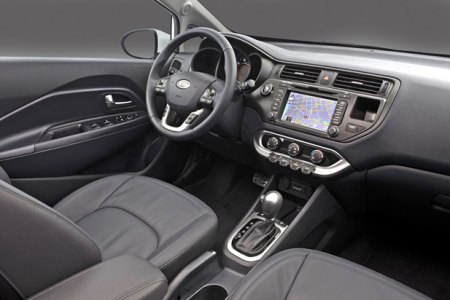Looking
back to the history of Kia Rio (or Pride in its home market), we can
see a rapidly improving breed. The
first
generation Rio was no more
than a 1-star car in our rating table, or in other words, a punishment
to those who could not afford a proper motor vehicle. The
second
generation took a giant leap. Although it was still far from the
level
of class leaders, it was reasonably good in most areas, and its
super-bargain price made it a viable choice for buyers with limited
budget. Now comes the Mk3. Naturally, we have high expectation on it,
especially having seen the world-class cars (Picanto and K5 / Optima)
KIA introduced recently. Will it be finally the car that we would
desire to own? Can it challenge Ford Fiesta, Volkswagen Polo and Honda
Jazz
for the laurels?
Let us see its sheet metal first. Once again Ex-VW-Audi designer Peter
Schreyer gave the Korean manufacturer something its home-grown
designers desperately needed: a high-quality European favour. A
prominent lower grille and slim "tiger nose" upper grille deliver a
sporty appearance, with strong family resemblance to Picanto. A
cab-forward proportion, high and rising waistline, crease lines on the
doors and subtly flared wheel arches follow modern European design
norms. While Ford Fiesta is prettier and VW Polo looks more timeless,
the Korean car is stylish enough to catch most customers. It has good
showroom appeal.

Being sold globally, the Rio / Pride is available in 3 body styles –
5-doors hatchback, 3-doors hatchback and 4-doors sedan. The first two
are
identical except the rear doors. They are certainly more stylish than
the 4-door sedan, whose proportion is compromised, i.e. neither 3-box
nor 2-box. The sedan looks different up front, with a larger tiger nose
and a slimmer lower grille, probably in the attempt to resemble the K5.
While its trunk offers more space in standard form, it loses the
convenience and versatility of the hatchbacks. Traditionally, sedan is
the preferred choice for the conservative motorists of China and North
America. However, as the shape of the Rio 4-door is not all that
conservative, I suspect this time around more sales will go to the
5-door.
The Korean manufacturer made use of its production cost advantage to
boost two things on the new Rio: size and spec. Compare with the old
car, it gets 55 mm longer and 45 mm wider. Although at 1455 mm it is
slightly less tall than the old car, its wheelbase is stretched by 70
mm. The latter boosts rear seat knee room by the same amount. Compare
with Fiesta and Polo, its wheelbase is 81 mm and 100 mm longer
respectively ! With so much extra metal, it doesn't take an especially
efficient packaging to realize a cabin space close to the level of
Honda Jazz. A pity the 288-liter boot of the hatchback is a tad small.

One thing the Korean has yet to catch European rivals is the interior
perceived quality. The Rio's instruments are clear and well layout. Fit
and finish is generally a match to its European rivals, but only the
top trim gets soft-touch plastic treatment on the dash top, yet it is
not as soft as in Polo or Fiesta. Elsewhere, it is mostly dark hard
plastic. Style-wise, it is a mixed bag. The toggle switches on the
center console try to make it different, but they do not work with the
expected precision. Some more faux metal or piano-black surfaces would
be a better idea.

Mechanically, the new Rio is perfectly up to date. It is built on the
same platform as Hyundai Accent. 63 percent of its body shell is made
of high-strength steel to lift torsional rigidity by 31 percent compare
with the last generation. The power steering is now assisted by
electric to save fuel. Efficiency is enhanced further by the Eco
package,
which includes auto engine stop-start, low rolling resistance tires,
drag-reducing spoilers and longer gearing. More forward gears also help
raising fuel economy – the manual box now gets 6 speeds instead of 5,
while the automatic takes a bigger leap from 4 to 6 speeds. Brakes have
been upgraded to discs all round.
All engines are more efficient yet more powerful. The range-topping
1.6-liter Gamma II engine gets a boost of 28 hp, thanks to direct
injection, dual-VVT and higher compression ratio, while all-alloy
construction cuts 13 kg from it. Other engines include a 108hp
1.4-liter Gamma, 87hp 1.25-liter Kappa and a couple of turbo diesel
motors for European market. The most efficient of which is the new
1.1-liter three-cylinder turbo diesel. It produces 75 hp, returns 88
mpg and emits only 85 grams of CO
2 per
kilometer, which is the cleanest car you can find in Europe.
However, the biggest selling engines are still the 1.4-liter and
1.6-liter petrol. Compare with its rival's smaller turbocharged motors,
they need to be revved harder to get the most out of them. This means
less flexibility and more noise in acceleration. Fortunately, the
smooth-shifting 6-speed manual box is a pleasant to use.
What let us down is the chassis dynamics. The Rio isn't a bad
performer, but it just fails to match the more polished Fiesta and
Polo. There is a touch more body roll and less agility in corner. It
glides over road imperfections with more shocks and noise, blame to a
stiff suspension setting. The steering is adequately weighted, but
totally lack of feel. On the plus side, it excels on braking and
high-speed stability. Motorway cruising is also quite refined, as the
engine rev is kept below the noisy zone.
Overall, the new Rio is of course a vast improvement from the old car.
However, it is still not in a position to challenge the best of the
class, especially in dynamics and perceived quality. Generous equipment
and a keen price
might save the game, but in case driving dynamics is your essential
requirement for purchasing a car, then there are better choices
elsewhere.